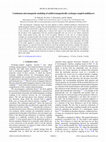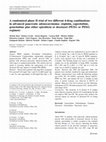Papers by Michele Ghidini
INTERMAG 2000 Digest of Technical Papers. 2000 IEEE International Magnetics Conference, 2000

Physical Review B, 2011
The micromagnetic continuum theory has been applied to perfect soft/hard multilayers characterize... more The micromagnetic continuum theory has been applied to perfect soft/hard multilayers characterized by antiferromagnetic interface coupling. The soft and hard phases have uniaxial anisotropy with a common direction, along which the external field is applied. The model assumes a nonuniform rotation of the magnetization, and it also considers an interface coupling that is reduced with respect to the strong-limit case. It is found that the deviation of the magnetization from the saturated antiparallel state can occur at two distinct nucleation fields, which mainly involve only one of the two phases. Moreover, in the case of a reduced interface coupling, the saturated parallel state becomes accessible and thus the nucleation from this state is taken into account. The critical equations have been deduced, allowing us to identify the conditions for which the nucleation regime changes from reversible to irreversible as a function of the intrinsic and extrinsic parameters. The results of the model, applied to a typical soft/hard system with planar anisotropy, have been summarized in suitable phase diagrams, as a function of the layer thicknesses and of the strength of the interface coupling. The analysis, supported by additional static and dynamic micromagnetic simulations, shows the occurrence of a rich variety of magnetization curves. As a secondary result we have found that, in the parallel nucleation process, the influence of the interface coupling extends inside the two phases to distances appreciably larger than the corresponding Bloch wall widths.
Applied Physics Letters, 2014
ABSTRACT In BaTiO3-based multilayer capacitors (MLCs) that show volatile magnetoelectric (ME) eff... more ABSTRACT In BaTiO3-based multilayer capacitors (MLCs) that show volatile magnetoelectric (ME) effects [C. Israel et al., Appl. Phys. Lett. 93, 173501 (2008)], a magnetic force microscopy study of the Ni electrode edges reveals non-volatile ME effects, due to the inhomogenous stress associated with an electric-field distribution that we model using finite-element analysis. Our findings imply that volatile ME effects in thin films may be rendered non-volatile by lithographic patterning, thus suggesting a route for the design of electric-write magnetic-read data-storage elements.
INTERMAG 2000 Digest of Technical Papers. 2000 IEEE International Magnetics Conference, 2000

Physical Review B, 2011
The micromagnetic continuum theory has been applied to perfect soft/hard multilayers characterize... more The micromagnetic continuum theory has been applied to perfect soft/hard multilayers characterized by antiferromagnetic interface coupling. The soft and hard phases have uniaxial anisotropy with a common direction, along which the external field is applied. The model assumes a nonuniform rotation of the magnetization, and it also considers an interface coupling that is reduced with respect to the strong-limit case. It is found that the deviation of the magnetization from the saturated antiparallel state can occur at two distinct nucleation fields, which mainly involve only one of the two phases. Moreover, in the case of a reduced interface coupling, the saturated parallel state becomes accessible and thus the nucleation from this state is taken into account. The critical equations have been deduced, allowing us to identify the conditions for which the nucleation regime changes from reversible to irreversible as a function of the intrinsic and extrinsic parameters. The results of the model, applied to a typical soft/hard system with planar anisotropy, have been summarized in suitable phase diagrams, as a function of the layer thicknesses and of the strength of the interface coupling. The analysis, supported by additional static and dynamic micromagnetic simulations, shows the occurrence of a rich variety of magnetization curves. As a secondary result we have found that, in the parallel nucleation process, the influence of the interface coupling extends inside the two phases to distances appreciably larger than the corresponding Bloch wall widths.
Applied Physics Letters, 2014
ABSTRACT In BaTiO3-based multilayer capacitors (MLCs) that show volatile magnetoelectric (ME) eff... more ABSTRACT In BaTiO3-based multilayer capacitors (MLCs) that show volatile magnetoelectric (ME) effects [C. Israel et al., Appl. Phys. Lett. 93, 173501 (2008)], a magnetic force microscopy study of the Ni electrode edges reveals non-volatile ME effects, due to the inhomogenous stress associated with an electric-field distribution that we model using finite-element analysis. Our findings imply that volatile ME effects in thin films may be rendered non-volatile by lithographic patterning, thus suggesting a route for the design of electric-write magnetic-read data-storage elements.
Pharmacogenomics, 2011
Association between DNA-repair polymorphisms and survival in pancreatic cancer patients treated w... more Association between DNA-repair polymorphisms and survival in pancreatic cancer patients treated with combination chemotherapy Pancreatic cancer remains a major unsolved health problem, representing the fourth leading cause of cancer-related death worldwide, with only 3% of patients alive 5 years after diagnosis [1].

Ejc Supplements, 2009
Background: PEFG regimen (P: cisplatin, E: epirubicin, F: 5-fluorouracil, G: gemcitabine) prolong... more Background: PEFG regimen (P: cisplatin, E: epirubicin, F: 5-fluorouracil, G: gemcitabine) prolonged significantly progression-free (PFS) and overall survival (OS) of patients with advanced pancreatic adenocarcinoma (PA) with respect to standard gemcitabine (Reni, Lancet Oncol 2005). The current trial was aimed to assess whether the replacement of E with docetaxel (D) may improve 6 months PFS (PFS6). Material and Methods: Chemo-naive patients with stage III or metastatic PA, age 18−75 y, Karnofsky performance status (PS) >50 received P (30 mg/m 2 day 1), G (800 mg/m 2 day 1) and capecitabine (1250 mg/m 2 /day days 1 to 14) and were randomized to receive either D at 25−30 mg/m 2 day 1 (arm A: PDXG regimen) or E at 30 mg/m 2 day 1 (arm B: PEXG regimen). Cycles were repeated every 14 days for a maximum of 6 months. The Fleming design was used to calculate the sample size on the probability of being PFS6 (primary endpoint). Assuming P0 = 40% and P1 = 60%, a 0.05 and b 0.10, the study was to enroll 52 patients per arm. The regimen had to be considered of interest with >26 patients being PFS6. Results: Between July 2005 and September 2008, 105 patients were enrolled at a single institution, stratified by stage and randomized (53 arm A). Patients' characteristics were (A/B): median age 61/59, PS > 70 92/88%, metastatic disease 66/65%; CA19.9 >upper limit of laboratory normal (ULN) 87/90%, median CA19.9 820/755 UI/mL. All patients are assessable for the primary endpoint: PFS6 was 59/56%. Median and 1 y OS was 10.7 and 41% in arm A and 10.7 and 43% in arm B. A partial response was observed in 60/37% of patients (p = 0.01). Among assessable patients with basal CA19.9 value >ULN (37 per arm), a major biochemical response (reduction >89%) was observed in 44/33% and a minor biochemical response (reduction between 50 and 89%) in 42/33% of patients (p = 0.03). No significant differences in quality of life were observed between arms. Altogether, 248 cycles of PDXG and 260 cycles of PEXG were administered. Main per cycle G3−4 toxicity was: neutropenia 4/13% (p = 0.0005), thrombocytopenia 2/4%, anemia 4/4%, fatigue 6/4%. Conclusions: PEXG yielded similar results when compared to prior series treated by PEFG, suggesting that capecitabine may replace F. The inclusion of D instead of E yielded more objective and biochemical responses and less G3−4 neutropenia but did not improve PFS and OS. The present trial confirms the relevant impact on outcome of advanced PA of four-drug regimens.
Chemotherapy, 2011
clusion: Based on the poor outcome observed and on the high level of grade 3-4 toxicity, the tria... more clusion: Based on the poor outcome observed and on the high level of grade 3-4 toxicity, the trial was prematurely stopped and the mitomycin and ifosfamide regimen was considered insufficiently active in gemcitabine-pretreated advanced pancreatic cancer.

Cancer Chemotherapy and Pharmacology, 2012
Purpose PEFG regimen (P:cisplatin, E:epirubicin, F:5-fluorouracil, G:gemcitabine) significantly p... more Purpose PEFG regimen (P:cisplatin, E:epirubicin, F:5-fluorouracil, G:gemcitabine) significantly prolonged progression-free (PFS) and overall survival (OS) of patients with advanced pancreatic adenocarcinoma (PA) with respect to standard gemcitabine. The current trial was aimed at assessing whether the replacement of E with docetaxel (D) may improve 6 months PFS (PFS6). Methods Chemo-naive patients with stage III or metastatic PA received P (30 mg/m 2 day 1 and 15), G (800 mg/m 2 day 1 and 15), and capecitabine (1,250 mg/m 2 /day days 1-28, without a break) and were randomized to receive either D at 25-30 mg/m 2 day 1 and 15 (arm A: PDXG regimen) or E at 30 mg/m 2 day 1 and 15 (arm B: PEXG regimen). Cycles were repeated every 28 days for a maximum of 6 months. The Fleming design was used to calculate the sample size on the probability of being PFS6. Assuming P0 = 40% and P1 = 60%, a = 0.05 and b = 0.10; the study was to enroll 52 patients per arm. Results Between July 2005 and September 2008, 105 patients were enrolled, stratified by stage and randomized. Patients' characteristics were (A/B) the following: median age 61/59, PS [70 92/88%, metastatic disease 66/65%. PFS6 was 58%, and median OS was 11 months in both arms. A partial response was observed in 60/37% of patients. Main per cycle G3-4 toxicity was the following: neutropenia 4/13%, thrombocytopenia 2/4%, anemia 4/4%, and fatigue 6/3%. Conclusions The inclusion of D instead of E yielded more objective response and less G3-4 neutropenia but did not improve PFS and OS. The present trial confirms the relevant impact on outcome of advanced PA of 4-drug regimens.











Uploads
Papers by Michele Ghidini